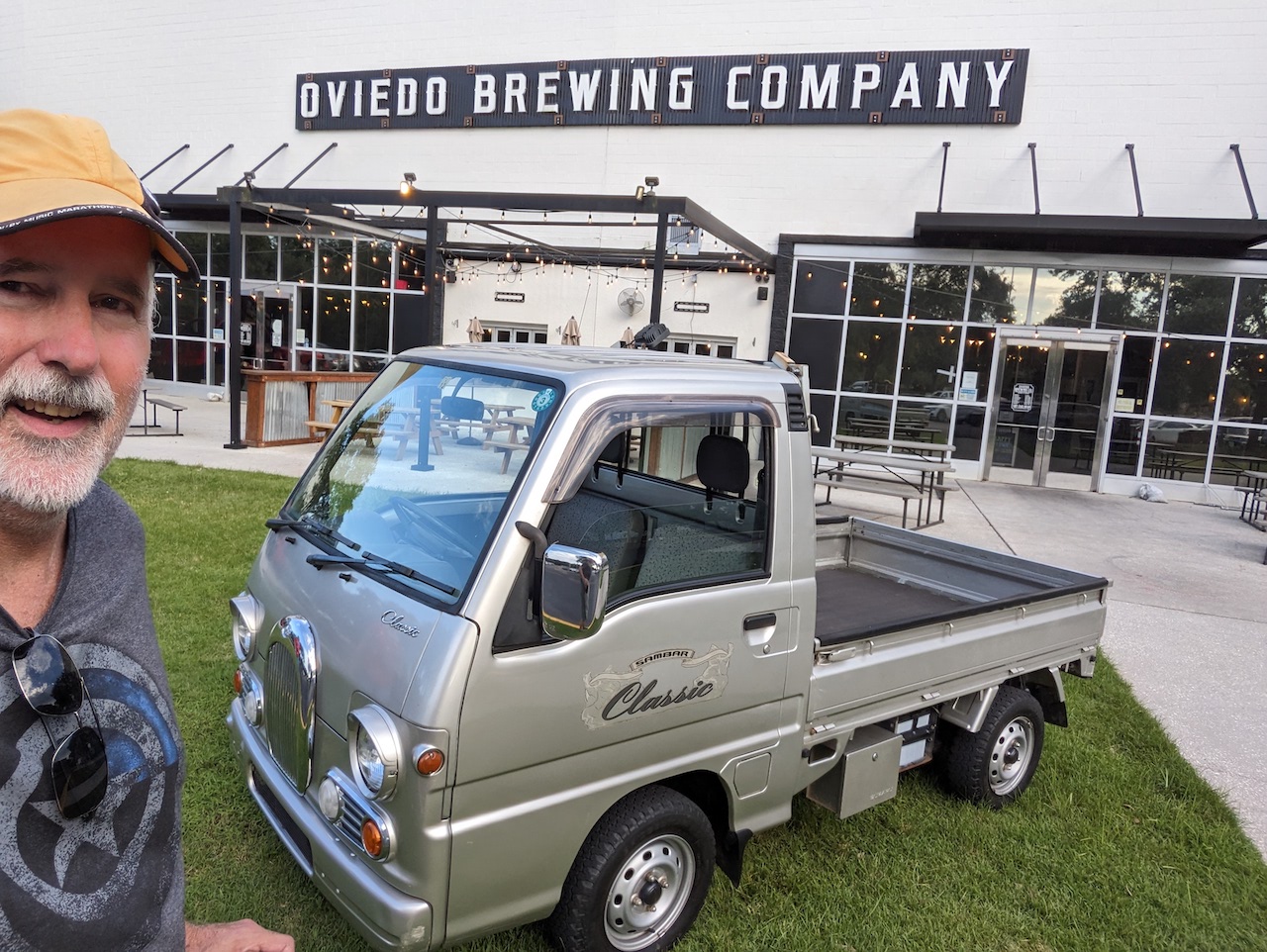We faced a task: to launch and retrieve the Sea-Doo Sportster from the lakefront beach while maneuvering within the confines of a narrow property line. The Nissan Rogue, with its all-wheel drive, was a suitable size for entering and exiting the lake. However, it was often unavailable and had poor rear visibility.
We considered alternatives like a used Jeep or a side-by-side vehicle. While appealing, finding a good deal was challenging. Many available options were either too expensive or in poor condition. Moreover, the side-by-side vehicle wasn’t road-legal. Despite this not being a primary concern, the ability to use such a vehicle for short trips would be valuable.
So, I started looking for a suitable vehicle. I spotted a Sambar on Craigslist and a few more on Facebook Marketplace, which kicked off my search.
Purchase Process: Time, Money, Risk
I don’t know these companies and can only speak for the one we went with, Japan Car FL.
Looking at the process, there appeared to be four purchase options:
- Register as a auto dealer in Japan. This involves jumping through a ton of hoops.
- Work with a Japan based vehicle exporter. The exporter will walk you through the entire process from inspection, one or more auctions, one or more vehicles, and finally delivery to a port near you. The purchase process to delivery takes 2-3 months.
- https://auc.japancardirect.com/
- https://carused.jp/
- Buy from a US importer. This is someone who went through option 1 or 2 and now has an inventory of vehicles in the US. This was the option I chose and was able to inspect and drive the vehicle before purchase.
- https://www.japancar-fl.com/
- https://www.mitsuicoltd.com/
- https://www.japan-partner.com/
- https://www.kurumaimports.com/
- Buy from a dealer or private owner.
- https://www.facebook.com/marketplace
- https://craigslist.org/
My Options and How I Imported My 1996 Subaru Sambar
I decided to purchase from a U.S.-based Japanese car importer, Japan Car FL. This decision allowed me to drive and inspect the vehicle before finalizing the purchase. It was a matter of balancing risk, trust, and timing. After several days of texting and sharing YouTube videos, I conducted a video inspection of the vehicle on the morning of the purchase. Satisfied with the inspection, I rented a trailer and traveled to the seller’s facility.
At the facility, I saw a dozen impressive Japanese cars and was pleased with my choice. The transaction, which included a PayPal deposit and a wire transfer, was completed within a few hours on the same day. My financial institution even called to conduct a fraud detection check and was satisfied with the process. Everything went smoothly, and I was able to negotiate, inspect, purchase, and receive the vehicle all in one day.
I strongly endorse Japan Car FL. When you contact them, please mention that you were referred by Matt.
Japan KEI Regulation & Standards, Keijidōsha
`The Japanese organization responsible for the regulations and standards of Kei cars is the Japanese government itself. KEI cars, also known as keijidōsha (軽自動車), is a category of the smallest highway-legal passenger cars in Japan. They are subject to certain restrictions in terms of dimensions and engine capacity. The kei car category was created by the Japanese government in 1949, and the regulations have been revised several times since.
These regulations specify a maximum vehicle size, engine capacity, and power output, so that owners may enjoy both tax and insurance benefits. In most rural areas, they are also exempted from the requirement to certify that adequate parking is available for the vehicle.
The regulations for kei cars have evolved over time. As of the latest revision:
- Maximum length: 3.4 m (11.2 ft)
- Maximum width: 1.48 m (4.9 ft)
- Maximum engine displacement: 660 cc
- Maximum power: 47 kW (64 PS)
Kei cars feature yellow license plates, earning them the name “yellow-plate cars”. They have also been subject to other restrictions, such as lower speed limits, including a warning chime that goes off if being driven too fast.
In April 2014, the Japanese government significantly reduced advantages for kei-car owners, imposing higher sales tax, higher gasoline tax, and a higher kei car tax – the last of which was raised by 50 percent – greatly reducing their tax benefits compared to regular-sized cars. You can add to this inspection and maintenance requirements.`
The US National Highway Traffic Safety Administration
`The US National Highway Traffic Safety Administration (NHTSA) is an agency of the U.S. federal government, part of the Department of Transportation. It was established by the Highway Safety Act of 1970 and is dedicated to achieving the highest standards of excellence in motor vehicle and highway safety.
If you have a Japanese vehicle that you’re importing to the United States, the vehicle will retain its original Japanese VIN. If the vehicle is over 25 years old, it is exempt from NHTSA requirements and can be legally imported and registered in the United States with its original VIN.
If the vehicle is less than 25 years old, it generally must be modified to meet US safety and emissions standards and may need to be assigned a new 17-character VIN by the Registered Importer handling the modifications. This process is regulated by NHTSA and the Environmental Protection Agency (EPA).`
Importing a 25-year-old vehicle from Japan to the U.S
Importing a 25-year-old vehicle from Japan to the U.S involves several steps. Specific steps you will perform depend on your purchase method.
Contact a Vehicle Exporter: You can choose a vehicle from their inventory or they can export a vehicle you’ve purchased from auctions. They will arrange and pay for transportation of the vehicle to the port, shipping from the port to your country, and insurance.
Pay for the Vehicle: This is usually done via bank transfer. After payment, the exporter will send you an original Bill of Lading (BOL), a commercial invoice, and a certificate of insurance.
Complete CBP Form 7501: This is the U.S. Customs and Border Protection form for importing goods into the U.S. It includes details about the vehicle and the import process.
Complete Department of Transportation HS-7 Short Form: This form is for the Department of Transportation and includes details about the vehicle and its safety features.
Fill out EPA Form 3520: This form is for the Environmental Protection Agency and includes details about the vehicle’s emissions.
File an ISF 10+2: This must be done within 24 hours of the vehicle being loaded onto the ship at the foreign port. It provides cargo and carrier information in advance to CBP.
Retrieve Your Shipment: Importers have 15 days to retrieve their shipment before the cargo is sent to a General Order Warehouse where storage charges will add up quickly.
Register Your Vehicle: Proceed to your Department of Licensing office and give them your remaining stamped form 7501, the Japan export certificate, and the commercial invoice.
Please note that this is a general guide and the exact process may vary depending on specific circumstances. It’s also important to note that the vehicle must be 25 years or older from the date of manufacture to be legally imported into the U.S. without having to meet DOT standards (21 years to be exempt from EPA standards).
For more detailed information, you can refer to this guide.
One More Thing, 9 Character VIN Numbers
My vehicle came with a 9 character VIN number, stamped into the frame, and on the title. It took me more than an hour on the phone with my insurance company to resolve the issue.
Even after explaining that low volume production vehicles fewer digits, and giving them the following reference, they would say, “Can you read the VIN number to be one more time?”
Low Volume (Grey) Import Vehicles which don’t have 17 Digit VIN. Uses NON ISO VIN with “Filler 0’s between WMI & Non Iso VIN – I.e Japanese VIN PV35-400637 would become 6U90000PV35400637 Wikipedia
To resolve the issue, I added “00000000”, eight zeros to my VIN number and the finally, I mean finally, the insurance company accepted it.


